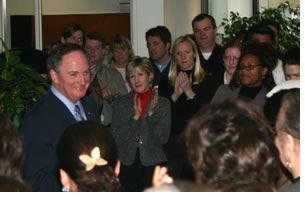

Koonce to Step Down
as AIA EVP/CEO on
December 31, 2005
 They had been
through a lot of turbulent times together in the early days—putting the
Institute’s financial house in order, bringing order and reliability
to the consolidated dues and membership database, developing a new generation
of electronic format contract documents, and responding to the aftermath
of 9/11. So when it came time to make an important announcement about
his future plans, AIA national component EVP/CEO Norman L. Koonce, FAIA,
gathered his professional family—the national component staff—in
the AIA Library on December 2 and announced his intention to retire next
year, on December 31, 2005.
They had been
through a lot of turbulent times together in the early days—putting the
Institute’s financial house in order, bringing order and reliability
to the consolidated dues and membership database, developing a new generation
of electronic format contract documents, and responding to the aftermath
of 9/11. So when it came time to make an important announcement about
his future plans, AIA national component EVP/CEO Norman L. Koonce, FAIA,
gathered his professional family—the national component staff—in
the AIA Library on December 2 and announced his intention to retire next
year, on December 31, 2005.
When asked why he decided to announce his retirement now, Koonce responded: “The AIA’s sesquicentennial is coming up in 2007. If I were to put off this decision for, say, another year or two, a successor would not have the time to develop a plan for observing this milestone in the AIA’s history. That simply would not be fair. Also, keep in mind that next December I will have served as the Institute’s EVP for seven years. That’s a long time.
“There are other issues of emerging importance to the profession that I am eager to pursue, such as the impact of technology on the design and construction industry, and working with neuroscientists. This is an area that particularly fascinates me. I am convinced we are on the threshold of developing evidence that will quantifiably prove the value of design. Imagine the possibilities; imagine sitting down with clients and being able to demonstrate the impact of design on learning, on healing, on productivity, on the cohesion of communities, and much more. That’s tremendous and I want to be part of it.
“Also, there is the pull of my own family—my four daughters, their husbands, my grandchildren, and, most importantly, my wife Sue. There comes a time when you really have to give more attention to the people with whom you share your life,” Koonce continued. “The process of interviewing and selecting a new CEO will be rational and transparent because the AIA already has a succession plan in place.”
Earlier Koonce informed the AIA Board in executive session of his decision. “If Norman were to leave today—which fortunately he is not!—it would be no exaggeration to say,” commented AIA President Eugene Hopkins, FAIA, “that his achievement was to elevate the AIA to a place where we, as an organization, are capable of doing anything we want. He has positioned the Institute and our members to address with confidence issues in the public realm to better serve society.”
2006 AIA President Kate Schwennsen, FAIA, noted: “The beneficiaries of his legacy are the current and future well-served clients and well-designed communities made possible by the AIA’s members.”
In sharing his thoughts, 2005 President Douglas Steidl, FAIA, remarked: “Norman has transformed the AIA, shaping it into a dynamic professional association focused on issues of relevance for architects and the society they serve. His leadership has made and continues to make a positive difference within our profession. Future generations of architects will be grateful for his ethical, sincere, and visionary service.”
“Of course I’m going to miss the day-to-day interaction with the truly wonderful people I’ve been privileged to work with,” Koonce reflected. “Their devotion to advancing our profession has been and is a constant source of inspiration. But the goodbyes are more than 12 months down the road. And I have no doubt that many of the friendships I’ve been fortunate to make with staff and the elected leadership are going to last long after that.”
Copyright 2004 The American Institute of Architects.
All rights reserved. Home Page ![]()
![]()
 |
||
|
||